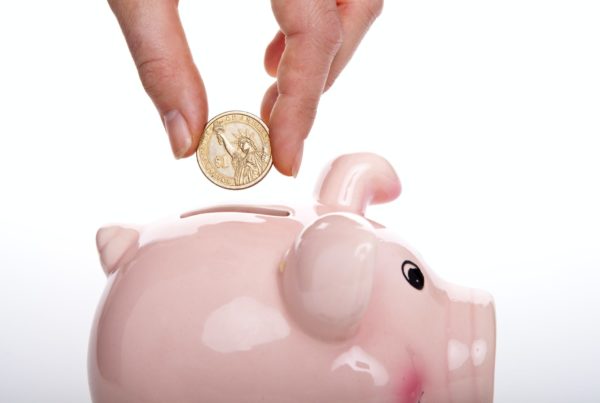Are you interested in learning how to save money? In this post, we will discuss the fundamentals of saving money. This includes understanding the mindset behind saving money, along with the most common reasons people don’t save. Furthermore, we will review a few key savings strategies. Read on to learn exactly how you can start saving today.
Learning to Save Money
Many people find it difficult to save money. Some people are frugal but have limited income. Meanwhile, others have large incomes but spend every dollar they earn – effectively still living paycheck to paycheck.
So, how can you save money when there’s nothing left at the end of the month? Like many things we know we should do, saving is easier said than done. Everyone knows saving for a rainy day is part of being financially secure. It requires planning ahead and delayed gratification.
Uncertain economic times tend to improve saving rates as people pull back to see what will happen. A good economy encourages people to spend. But the savings rate in America has actually improved in the past decade more than expected, possibly because the fallout from 2008 made it harder for some to borrow money. Even so, the Federal Reserve says 12% of us couldn’t afford an unexpected $400 bill. And sadly, a lot of people are facing compromised income right now.
Even under steady economic circumstances, if your money story is clouded by a painful past that you have not addressed, you will sabotage your saving plan. For example, if you are living from a scarcity mindset and you believe that storing up money for yourself is wrong when others need it now, you will never let yourself accumulate money. This is true even if your belief is subconscious, and even if your rational self knows you will be in a better position to help others by making yourself financially stable.
These challenges don’t mean you get a free pass to ignore saving. But you may need to address your money story around saving before you can reconcile the rational reasons with the voice that is keeping you from your goals. If you are struggling financially right now, many of the steps for saving have to do with evaluating your spending. You may find this exercise helpful now as you look for extra ways to stretch your income.
Why Can’t I Save Money?
Speaking of your money story, let’s explore that a bit more right now.
People often find themselves asking themselves, “Why can’t I save money?” The real answer often goes deeper than simple math or budgeting.
Having coached over a thousand clients (rich and poor alike), I have come to realize we often don’t save money because we are living in a state of crisis. Whether real or imagined, the “crisis” we feel drives our inability to save. This is especially true if you grew up with trauma, or have experienced some type of trauma, at any point during your life.
In my personal case, I lost everything after the Great Recession of 2008. My income, lifestyle, and sense of worth all disappeared overnight. Moreover, I lost my brother Keith after he committed suicide due to his money shame. Many of you were also there in 2008, and so you know just how horrible that time was. Worst of all, our country is going through a similar crisis again now.
After I started picking up the pieces, I realized the real reason most people can’t save money: They have money shame that influences their internal belief system and undermines their financial choices. This realization allowed me to start healing my own money shame, and ultimately to start a business helping others do the same.
Money Detox: The Real Key to Saving Money
The process of healing your money shame is called Money Detox. This is also the name of my book that I wrote on this same topic. While there isn’t time to cover all of that detail here, I can at least point you in the right direction.
For starters, consider the following question: What are the money beliefs holding you back from saving money?
Really listen to yourself and see what comes up, because you might be surprised. For example, you might believe you deserve more than you currently have. Alternatively, you might believe saving money for yourself is selfish. After all, saving that money could be keeping it out of the hands of a friend or family member who desperately needs it.
Other money beliefs that may be working against you include:
- Thinking you don’t earn enough to save money
- Believing that you are not deserving of nice things
- Feeling like you’ll work forever anyways, so why save money in the first place?
- Struggling to admit when you are living beyond your means
- Not seeing oneself as “being good with money” or numbers
What’s more, these are just a few examples! In reality, your money story and money beliefs are likely to be even more personal and complex. The important thing is that you begin working to understand them, because this is the first step towards learning how to save money. After this process of identification, you can move onto the remaining steps in the money detox process.
With that in mind, let’s continue pushing forward by discussing some additional ways to save money.
Why Do I Want to Save

A specific list of “whys” is more compelling than one account for generic savings. You can also prioritize those accounts. Maybe you are putting money into the vacation fund only if you can match that amount in one of the needs-to-save categories.
Once you have your whys labeled as separate accounts to keep yourself on track, where does this extra money come from? It all comes down to increased money coming in or decreased spending, whether you bring in extra income or make room in your current budget. You may be receiving a tax refund or a stimulus check soon. I talk more about using that money to kick start your savings here.
Start with a Budget
A budget should be your starting place for finding funds. It’s the best way to visualize exactly where your money is going each month and where you are overspending. Then you can use your budget to “tell” your money where you want it to go. It empowers you to make decisions while you have the big picture in front of you, not while you are standing in the checkout line.
You can use a journal to write your actual purchases down as you make them or go to your online account if you can remember what each purchase represents. For example, Target could mean a lot of things—new bedspread, beer, clothing??? Details are important. You need to know exactly what each purchase is before you will get any practical use out of this exercise.
Categorize your purchases in a way that makes sense for you. Some buckets could be groceries, eating out, clothing, makeup, gasoline, entertainment etc. The constant bills will be easy to log (car payment, mortgage, utilities).
Finding the Money to Save
Writing down all your expenses…everything you spend in a month, should cause patterns to emerge. Seeing what is coming in vs. going out can be eye opening. The following are some places where it’s easy to overspend that may need to be revisited if they take up an inflated portion of your income:
#1 The House
The elephant in the room: we have to address living expenses. It should be a priority to live within or below your means. Yes, you need shelter, but if you find you are spending an inordinate amount on your home, you may have to consider making changes. This is a tough pill to swallow because your home can be a big part of your identity and money dreams. Where you live may give you a sense of status, but your house is not a reflection of your self-worth. And of course, a bigger house comes with other expenses, from higher utilities, maintenance, more furnishings—not to mention a different pressure to keep up with the neighbors. No amount of budgeting and cutting corners on smaller purchases can offset a too-high mortgage payment.
You need to get real about what you are trading for this particular house. Is it worth stealing from your future goals and security to stay in this home? How could a smaller mortgage help you move toward your whys?
#2 Transportation
Leasing a car is the most expensive way to drive, and another way that people overspend. It’s how dealerships put people into cars they really can’t afford. I love cars, so I can relate to the desire of having that new car smell and pulling up to your destination in a luxury car. But you will pay for that car many times over if you lease, and the temptation to trade in for a newer model while you maintain those payments is a cycle that can go on forever.
“My clients expect me to drive a new car as proof of my success. It helps me drive more business.” While there can be some truth to that statement, I would challenge you to consider if this is really a stepping stone for your job. If you are a realtor and driving people around, you are able to deduct some of the costs of insurance, mileage, and repairs. But if your position is at a corporate office, and you just want your car to fit in with the others in the parking deck, you may be stretching the requirement for a flashy ride.
Consider that a slightly used luxury car can be purchased for thousands less than a new car. Once you pay off the tab, you may have several years without a payment, and that money could be so easily diverted to savings. Then when you are ready to buy again, you have something to trade in to further decrease the price of that next vehicle.
#3 All the Little Things
What about your day-to day spending is sabotaging your budget? High interest debt needs to be addressed immediately. If you have credit card debt, eradicate this first. Nothing drags down your budget like continuing to pay high interest on items you bought weeks ago. If you are deeply in debt, you may need to find a side gig or part-time job to help close the gap. It’s very hard to save money when interest payments are eating up a large proportion of your income. And it would be unwise to direct your money to savings when you can save more money by paying off debt than you could earn in savings interest.
Eating out can be a huge money suck, and this is often an easy change that can make a big impact. I’m not saying you can’t eat out again or you should never buy a Starbucks coffee, but if grabbing food on the go is your everyday or several times a day habit, preparing more meals at home will save you money and often improve your health.
Review any monthly subscriptions that you may have forgotten about. You may be able to save a few dollars by cancelling a gym membership you no longer use, a monthly gift box you subscribe to, online software you had forgotten about, or your membership to a warehouse store you rarely visit.
Make it Seamless
Once you have identified money you can save each month (and for what causes), automate your saving. Make sure the money is deducted directly from your checking account monthly and placed in separate saving accounts in a harder-to-reach location. For example, an online bank you don’t use for your main checking account. It’s too easy to borrow from your savings if it’s in an account at the same bank where your checking is. Make sure it is not tied to your checking account as overdraft protection.
Watching your savings grow will become addictive (in a good way). When you have a name attached to each goal and you watch the progress towards your vacation or new couch or whatever it is, your confidence will grow as you have the ability to pay ahead for large purchases instead of going into debt. Your spending is proactive instead of reactive. With a budget, you’ll feel control over how your money is working for you each month.





